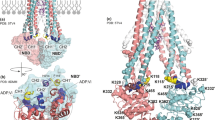Abstract
ModA is a soluble periplasmic molybdate-binding protein found in most gram-negative bacteria. It is part of the ABC transporter complex ModABC that moves molybdenum into the cytoplasm, to be used by enzymes that carry out various redox reactions. Since there is no clear analog for ModA in humans, this protein could be a good target for antibacterial drug design. Backbone 1H, 13C and 15N chemical shifts of apo and molybdate-bound ModA from E. coli were assigned at pHs 6.0 and 4.5. In addition, side chain atoms were assigned for apo ModA at pH 6.0. When comparing apo and molybdate-bound ModA at pH 6.0, large chemical shift perturbations are observed, not only in areas near the bound metal, but also in regions that are distant from the metal-binding site. Given the significant conformational change between apo and holo ModA, we might expect the large chemical shift changes to be more widespread; however, since they are limited to specific regions, the residues with large perturbations may reveal allosteric sites that could ultimately be important for the design of antibiotics that target ModA.




Similar content being viewed by others
Data availability
Chemical shift assignment data have been deposited to the BioMagResBank (BMRB) with accession numbers 52193 and 52200.
References
Chan S, Giuroiu I, Chernishof I, Sawaya MR, Chiang J, Gunsalus RP, Arbing MA, Perry LJ (2010) Apo and ligand-bound structures of ModA from the archaeon Methanosarcina acetivorans. Acta Crystallogr Sect F Struct Biol Cryst Commun 66:242–250. https://doi.org/10.1107/S1744309109055158
Delaglio F, Grzesiek S, Vuister GW, Zhu G, Pfeifer J, Bax A (1995) NMRPipe: a multidimensional spectral processing system based on UNIX pipes. J Biomol NMR 6:277–293. https://doi.org/10.1007/bf00197809
Delaglio F, NMRPipe, NMRDraw v.9.6 (2018) NMR Science, North Potomac, MD.
Hille R, Hall J, Basu P (2014) The mononuclear molybdenum enzymes. Chem Rev 114:3963–4038. https://doi.org/10.1021/cr400443z
Hollenstein K, Frei DC, Locher KP (2007) Structure of an ABC transporter in complex with its binding protein. Nature 446:213–216. https://doi.org/10.1038/nature05626
Hu Y, Ribbe MW (2013) Biosynthesis of the iron-molybdenum cofactor of nitrogenase. J Biol Chem 288:13173–13177. https://doi.org/10.1074/jbc.R113.454041
Hu Y, Rech S, Gunsalus RP, Rees DC (1997) Crystal structure of the molybdate binding protein ModA. Nat Struct Biol 4:703–707. https://doi.org/10.1038/nsb0997-703
Johnson BA, Blevins RA (1994) NMR view - a computer-program for the visualization and analysis of NMR data. J Biomol NMR 4:603–614. https://doi.org/10.1007/BF00404272
Johnson BA, NMRViewJ v92 (2016) One Moon scientific, Inc., Newark, NJ.
Kisker C, Schindelin H, Rees DC (1997) Molybdenum-cofactor-containing enzymes: structure and mechanism. Annu Rev Biochem 66:233–267. https://doi.org/10.1146/annurev.biochem.66.1.233
Leimkuhler S (2020) The biosynthesis of the molybdenum cofactors in Escherichia coli. Environ Microbiol 22:2007–2026. https://doi.org/10.1111/1462-2920.15003
Marsh JA, Singh VK, Jia Z, Forman-Kay JD (2006) Sensitivity of secondary structure propensities to sequence differences between alpha- and gamma-synuclein: implications for fibrillation. Protein Sci 15:2795–2804. https://doi.org/10.1110/ps.062465306
Maunders EA, Ngu DHY, Ganio K, Hossain SI, Lim BYJ, Leeming MG, Luo Z, Tan A, Deplazes E, Kobe B, McDevitt CA (2022) The impact of chromate on Pseudomonas aeruginosa molybdenum homeostasis. Front Microbiol 13:903146. https://doi.org/10.3389/fmicb.2022.903146
Maupin-Furlow JA, Rosentel JK, Lee JH, Deppenmeier U, Gunsalus RP, Shanmugam KT (1995) Genetic analysis of the modABCD (molybdate transport) operon of Escherichia coli. J Bacteriol 177:4851–4856. https://doi.org/10.1128/jb.177.17.4851-4856.1995
Nerli S, McShan AC, Sgourakis NG (2018) Chemical shift-based methods in NMR structure determination. Prog Nucl Magn Reson Spectrosc 106–107:1–25. https://doi.org/10.1016/j.pnmrs.2018.03.002
Rahman MM, Machuca MA, Roujeinikova A (2021) Bioinformatics analysis and biochemical characterisation of ABC transporter-associated periplasmic substrate-binding proteins ModA and MetQ from Helicobacter pylor strain SS1. Biophys Chem 272:106577. https://doi.org/10.1016/j.bpc.2021.106577
Rech S, Deppenmeier U, Gunsalus RP (1995) Regulation of the molybdate transport operon, modABCD, of Escherichia coli in response to molybdate availability. J Bacteriol 177:1023–1029. https://doi.org/10.1128/jb.177.4.1023-1029.1995
Rech S, Wolin C, Gunsalus RP (1996) Properties of the periplasmic ModA molybdate-binding protein of Escherichia coli. J Biol Chem 271:2557–2562. https://doi.org/10.1074/jbc.271.5.2557
Stiefel EI (1993) Molybdenum enzymes, cofactors, and chemistry. In molybdenum enzymes, cofactors, and model systems. Am Chem Soc 535:1–19. https://doi.org/10.1021/bk-1993-0535
Zhong Q, Kobe B, Kappler U (2020) Molybdenum enzymes and how they support virulence in pathogenic Bacteria. Front Microbiol 11:615860. https://doi.org/10.3389/fmicb.2020.615860
Acknowledgements
Thanks go to Nicholas Mead for assistance with protein expression and purification. We are grateful to the National Institute of General Medical Sciences of the National Institutes of Health (award number SC3GM116745) for supporting this research, and for a Major Research Instrumentation grant to purchase a 600 MHz NMR spectrometer provided by the National Science Foundation (award number CHE-1040134).
Author information
Authors and Affiliations
Contributions
H.N. made the protein samples, performed the majority of the chemical shift assignments, wrote portions of the manuscript and made part of Fig. 2; K.C. performed some of the assignments, deposited the data to the BMRB, wrote the majority of the manuscript and made the remaining figures. Both authors reviewed the manuscript.
Corresponding author
Ethics declarations
Competing interests
The authors declare no competing interests.
Additional information
Publisher’s Note
Springer Nature remains neutral with regard to jurisdictional claims in published maps and institutional affiliations.
Rights and permissions
Springer Nature or its licensor (e.g. a society or other partner) holds exclusive rights to this article under a publishing agreement with the author(s) or other rightsholder(s); author self-archiving of the accepted manuscript version of this article is solely governed by the terms of such publishing agreement and applicable law.
About this article
Cite this article
Nguyen, H.L., Crowhurst, K.A. Solution NMR chemical shift assignment of apo and molybdate-bound ModA at two pHs. Biomol NMR Assign 18, 93–98 (2024). https://doi.org/10.1007/s12104-024-10173-7
Received:
Accepted:
Published:
Issue Date:
DOI: https://doi.org/10.1007/s12104-024-10173-7




